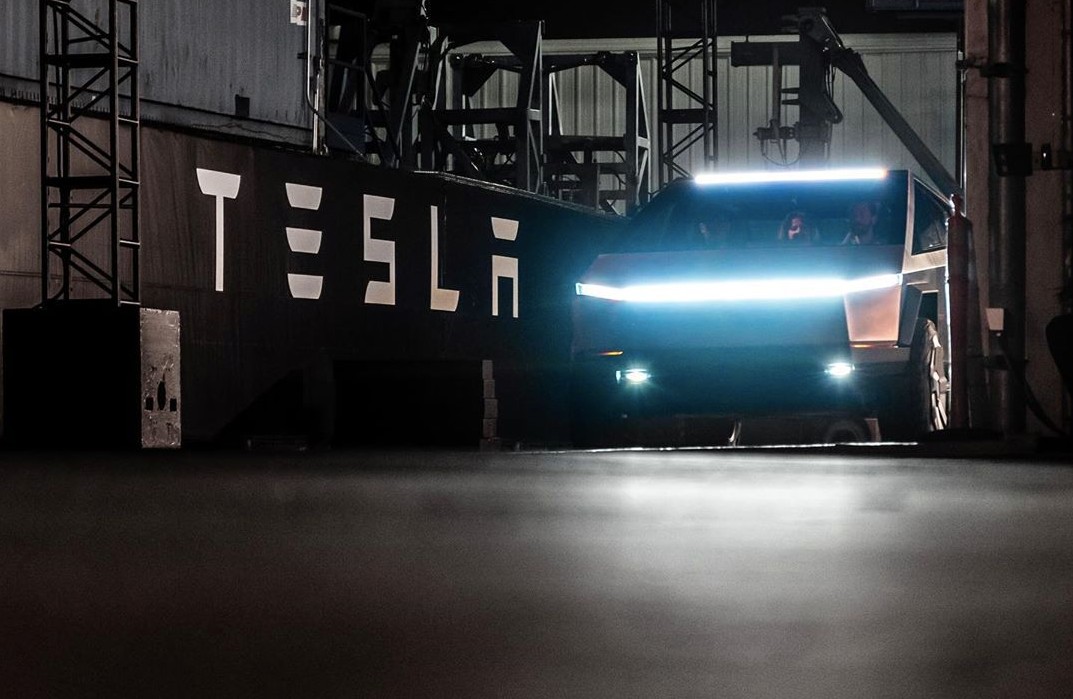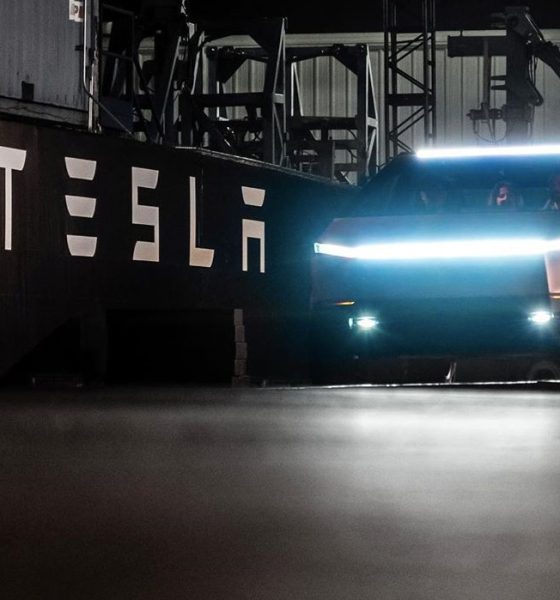

News
Tesla Cybertruck’s ‘V4′ charging hints at Plaid Model S’ monster peak charge rate
During the Tesla Cybertruck’s unveiling last November, CEO Elon Musk subtly commented that the all-electric pickup would be capable of charging at more than 250 kW. Musk did not disclose any other details about the Cybertruck’s possible “V4” Supercharging support, though the innovations that make it possible may very well be tailor-fit for the company’s next-generation of vehicles like the Plaid Model S and Plaid Model X.
The mention of the Cybertruck’s peak charge rate came at the latter part of the vehicle’s unveiling. Unfortunately, Elon Musk was already a bit shaken then due to the vehicle’s failed Armor Glass demonstration. Thus, the CEO’s mention of the key feature almost sounded like an afterthought, with Musk simply stating that the Cybertruck will “be capable of more than 250 kW.” He also mentioned that Tesla will “reveal the actual number later.”
In a way, an improved peak charge rate for the Cybertruck that goes beyond 250 kW is very well within character for the electric car maker. Tesla, after all, appears to be in the habit of introducing upgraded charging systems with every generation of its vehicles. The company’s first and second-generation 120 kW Superchargers were rolled out alongside the ramp of the Model S and Model X, and the 250 kW Supercharger V3 was introduced to support the ramp of the higher volume Model 3 and the Model Y.
With this in mind, there seems to be a pretty good chance that Tesla is preparing “V4” Superchargers for its next generation of vehicles. Tesla’s coming electric cars are expected to have the company’s best and possibly largest battery packs to date, after all, as represented by the Plaid Model S, Plaid Model X, Cybertruck, and perhaps even the Semi. Considering Tesla’s pace of innovation, it may not be surprising if the company’s peak charge rate for the Cybertruck, Plaid Model S, and Plaid Model X ends up being on par or higher than 350 kW.
This who have followed Elon Musk’s tweets over the past years would remember a post back in December 2016 when the CEO mentioned that a peak charge rate of 350 kW was more akin to a “children’s toy.” Musk’s statement may simply be a playful jab at the 350 kW peak charge rates of other charging networks, such as IONITY in Europe and Electrify America, but it does hint that the electric car maker is considering the introduction of a charging system that peaks beyond 350 kW. Since very few vehicles today like the Porsche Taycan are capable of supporting 350 kW charging, a “V4” Supercharger that goes beyond 350 kW would allow Tesla to leapfrog its competitors once more.
Such a strategy is actually well within character for the electric car maker, seeing as the company also has a tendency to give competitors a short-lived edge before leapfrogging them. This was the case with the Taycan’s track capability, which was designed to overcome and crush the capabilities of the Model S. Following the Taycan’s unofficial record run at the Nurburgring, Elon Musk announced that the flagship Tesla sedan was taking on the notorious track too, and sure enough, the Plaid Model S completely walked over the Taycan’s unofficial record.
That being said, and with Tesla’s tendency to innovate in mind, it appears safe to assume that the current V3 Superchargers still have a long way to go. The 250 kW chargers are still quite early in their rollout, and thus, Tesla is almost certain to upgrade them and increase their peak charge capabilities in the future. That was the strategy that the company adopted for its V2 Superchargers, which could now charge up to 150 kW. Regardless of whether the Cybertruck’s over 250 kW peak charge rate is due to a “V4” or an upgraded V3 Supercharger, however, there is very little doubt that the next generation of EV fast chargers will be dominated by Tesla once more.

News
Tesla FSD fleet is nearing 7 billion total miles, including 2.5 billion city miles
As can be seen on Tesla’s official FSD webpage, vehicles equipped with the system have now navigated over 6.99 billion miles.

Tesla’s Full Self-Driving (Supervised) fleet is closing in on almost 7 billion total miles driven, as per data posted by the company on its official FSD webpage.
These figures hint at the massive scale of data fueling Tesla’s rapid FSD improvements, which have been quite notable as of late.
FSD mileage milestones
As can be seen on Tesla’s official FSD webpage, vehicles equipped with the system have now navigated over 6.99 billion miles. Tesla owner and avid FSD tester Whole Mars Catalog also shared a screenshot indicating that from the nearly 7 billion miles traveled by the FSD fleet, more than 2.5 billion miles were driven inside cities.
City miles are particularly valuable for complex urban scenarios like unprotected turns, pedestrian interactions, and traffic lights. This is also the difference-maker for FSD, as only complex solutions, such as Waymo’s self-driving taxis, operate similarly on inner-city streets. And even then, incidents such as the San Francisco blackouts have proven challenging for sensor-rich vehicles like Waymos.
Tesla’s data edge
Tesla has a number of advantages in the autonomous vehicle sector, one of which is the size of its fleet and the number of vehicles training FSD on real-world roads. Tesla’s nearly 7 billion FSD miles then allow the company to roll out updates that make its vehicles behave like they are being driven by experienced drivers, even if they are operating on their own.
So notable are Tesla’s improvements to FSD that NVIDIA Director of Robotics Jim Fan, after experiencing FSD v14, noted that the system is the first AI that passes what he described as a “Physical Turing Test.”
“Despite knowing exactly how robot learning works, I still find it magical watching the steering wheel turn by itself. First it feels surreal, next it becomes routine. Then, like the smartphone, taking it away actively hurts. This is how humanity gets rewired and glued to god-like technologies,” Fan wrote in a post on X.
News
Tesla starts showing how FSD will change lives in Europe
Local officials tested the system on narrow country roads and were impressed by FSD’s smooth, human-like driving, with some calling the service a game-changer for everyday life in areas that are far from urban centers.

Tesla has launched Europe’s first public shuttle service using Full Self-Driving (Supervised) in the rural Eifelkreis Bitburg-Prüm region of Germany, demonstrating how the technology can restore independence and mobility for people who struggle with limited transport options.
Local officials tested the system on narrow country roads and were impressed by FSD’s smooth, human-like driving, with some calling the service a game-changer for everyday life in areas that are far from urban centers.
Officials see real impact on rural residents
Arzfeld Mayor Johannes Kuhl and District Administrator Andreas Kruppert personally tested the Tesla shuttle service. This allowed them to see just how well FSD navigated winding lanes and rural roads confidently. Kruppert said, “Autonomous driving sounds like science fiction to many, but we simply see here that it works totally well in rural regions too.” Kuhl, for his part, also noted that FSD “feels like a very experienced driver.”
The pilot complements the area’s “Citizen Bus” program, which provides on-demand rides for elderly residents who can no longer drive themselves. Tesla Europe shared a video of a demonstration of the service, highlighting how FSD gives people their freedom back, even in places where public transport is not as prevalent.
What the Ministry for Economic Affairs and Transport says
Rhineland-Palatinate’s Minister Daniela Schmitt supported the project, praising the collaboration that made this “first of its kind in Europe” possible. As per the ministry, the rural rollout for the service shows FSD’s potential beyond major cities, and it delivers tangible benefits like grocery runs, doctor visits, and social connections for isolated residents.
“Reliable and flexible mobility is especially vital in rural areas. With the launch of a shuttle service using self-driving vehicles (FSD supervised) by Tesla in the Eifelkreis Bitburg-Prüm, an innovative pilot project is now getting underway that complements local community bus services. It is the first project of its kind in Europe.
“The result is a real gain for rural mobility: greater accessibility, more flexibility and tangible benefits for everyday life. A strong signal for innovation, cooperation and future-oriented mobility beyond urban centers,” the ministry wrote in a LinkedIn post.
News
Tesla China quietly posts Robotaxi-related job listing
Tesla China is currently seeking a Low Voltage Electrical Engineer to work on circuit board design for the company’s autonomous vehicles.

Tesla has posted a new job listing in Shanghai explicitly tied to its Robotaxi program, fueling speculation that the company is preparing to launch its dedicated autonomous ride-hailing service in China.
As noted in the listing, Tesla China is currently seeking a Low Voltage Electrical Engineer to work on circuit board design for the company’s autonomous vehicles.
Robotaxi-specific role
The listing, which was shared on social media platform X by industry watcher @tslaming, suggested that Tesla China is looking to fill the role urgently. The job listing itself specifically mentions that the person hired for the role will be working on the Low Voltage Hardware team, which would design the circuit boards that would serve as the nervous system of the Robotaxi.
Key tasks for the role, as indicated in the job listing, include collaboration with PCB layout, firmware, mechanical, program management, and validation teams, among other responsibilities. The role is based in Shanghai.
China Robotaxi launch
China represents a massive potential market for robotaxis, with its dense urban centers and supportive policies in select cities. Tesla has limited permission to roll out FSD in the country, though despite this, its vehicles have been hailed as among the best in the market when it comes to autonomous features. So far, at least, it appears that China supports Tesla’s FSD and Robotaxi rollout.
This was hinted at in November, when Tesla brought the Cybercab to the 8th China International Import Expo (CIIE) in Shanghai, marking the first time that the autonomous two-seater was brought to the Asia-Pacific region. The vehicle, despite not having a release date in China, received a significant amount of interest among the event’s attendees.








